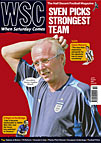 Forget about dodgy bounces at Kenilworth Road, plastic is back and, if it can get past a bit of red tape, could be the answer to football’s problems. As Steve Menary explains, they’re even complaining about the quality of the grass in Amsterdam
Forget about dodgy bounces at Kenilworth Road, plastic is back and, if it can get past a bit of red tape, could be the answer to football’s problems. As Steve Menary explains, they’re even complaining about the quality of the grass in Amsterdam
This was supposed to be the year of the artificial turf revolution, so where is it? Not that awful plastic stuff that left players with terrible burns, but a hi-tech mixture of man-made fibre and real grass has been allowed in the Champions League, UEFA Cup and Intertoto Cup for the first time this season.X
UEFA’s decision followed a batch of trials at several clubs across Europe. Dunfermline took part along with one side each from Holland, Sweden, Turkey and Austria. None was likely to take Europe by storm and the €195,000 (£135,000) subsidy may well have influenced clubs applying to join the pilot as much as anything else. Dunfermline’s pitch was slated and eventually taken up after a legal wrangle this summer, but the sixth club in the trials are an altogether different proposition. Top Russian side Torpedo Moscow had an artificial turf laid in their Luzhniki Stadium and even staged the first senior UEFA match on an artificial pitch, in August 2003, when San Marino amateurs Domagnano gracefully accepted that they had no chance of winning and braved the turf.
After thumping the Sammarinesi 5-0, Torpedo found that their next opponents CSKA Sofia had more ambition. The match was switched to another stadium in Moscow with a grass pitch, where, after 1-1 draws in both legs, Torpedo won 3-2 on penalties.
Torpedo’s next opponents, Villarreal, were more bothered by the impending Russian winter than the artificial pitch, so agreed to play to get the game on. Despite losing 1-0, Villarreal went through 2-1 on aggregate and the experiment was over – till now.
John Gillman, whose firm FieldTurf laid the surface at the Luzhniki, claimed that up to 15 clubs playing regularly in the Champions League would buy artificial turf once it was approved by UEFA. Despite problems at Dunfermline and Denizlispor in Turkey, UEFA agreed last year to use the same criteria to license pitches as FIFA. The International Football Association Board also altered the laws of the game to permit the use of artificial turf. But the floodgates have not opened, not even to a trickle, partly because individual associations set their own rules and many remain less convinced than UEFA.
In England, the Unibond League supported Stockport side Woodley Sport’s decision to lay a fake pitch for this season, but grass must be used in the FA Cup and from the Premiership down to the Conference. If a non-League club with an artificial pitch enters knock-out competitions, matches must be switched to a neutral venue and all the expenses met directly by the host club and not from the gate receipts for the match. That stance will hardly encourage any clubs and a similar story is evident across Europe.
Ajax, whose pitch in Amsterdam has been ripped up many times and relaid, each time at a six-figure cost, due to lack of light and air caused by the stadium’s retractable roof, have also considered artificial turf, but not yet made the move.
Moldovan champions FC Sheriff Tiraspol did buy an artificial surface from FieldTurf. When the club retained the Moldovan title in 2004-05, the first Champions League fixture on artificial turf appeared possible, but Sheriff’s victory over Maltese side Sliema and loss in the next round to Partizan Belgrade were played in the old stadium rather than the brand new arena next door with the artificial turf. Attempts to play Moldova internationals at the new ground have been hindered by the location, in the breakaway state of Transdniestra, but UEFA refuses to explain why the Champions League matches were not played on the new pitch.
With FIFA approving the surface, ten matches at the 2003 World Under-17 Championship, including the final, were played on the artificial pitch at the 11,000-seat Toolo Stadium in Helsinki, Finland. Theoretically a World Cup final could be played on the surface following FIFA and UEFA’s accord, but the change in the laws of the game was too late for Germany 2006. The surface will have to wait longer for its major international debut: that could come in the 2010 finals in South Africa, where there are problems maintaining grass pitches and Pelé has been urging artificial turf as the solution.
From WSC 224 October 2005. What was happening this month